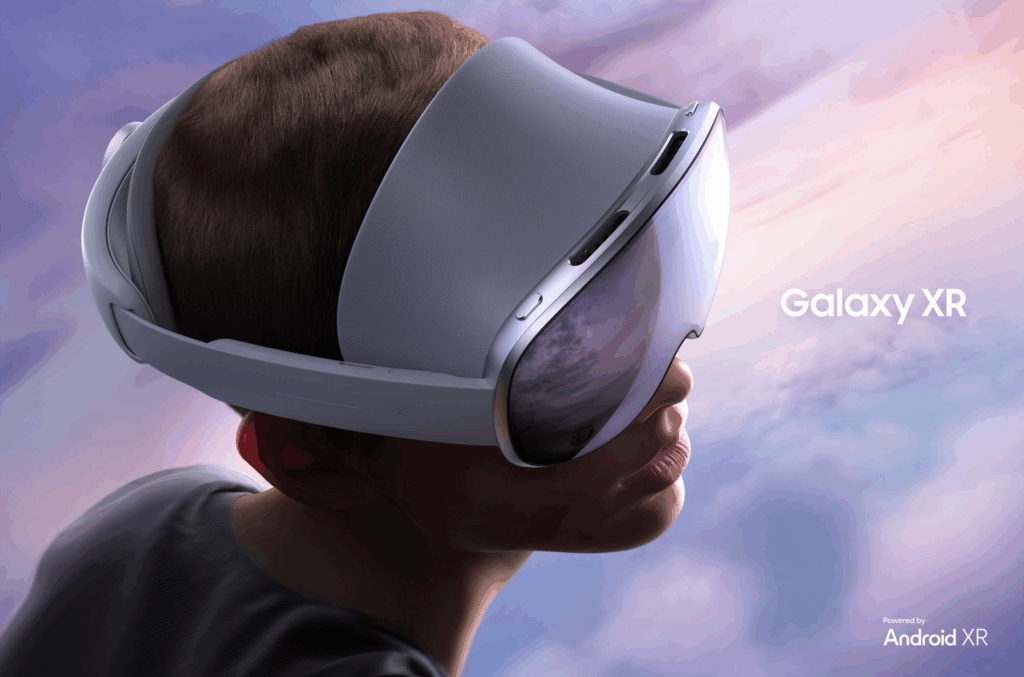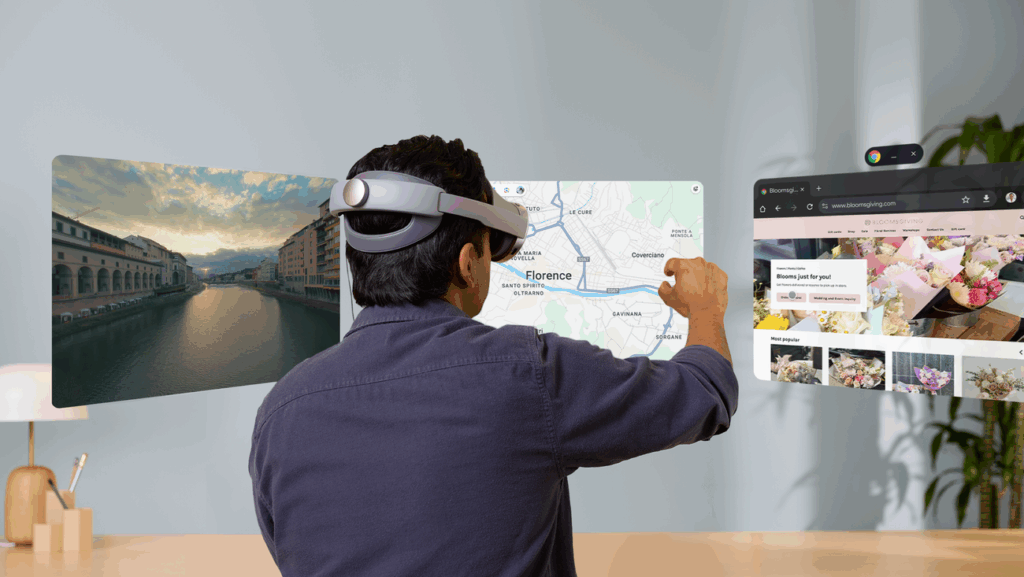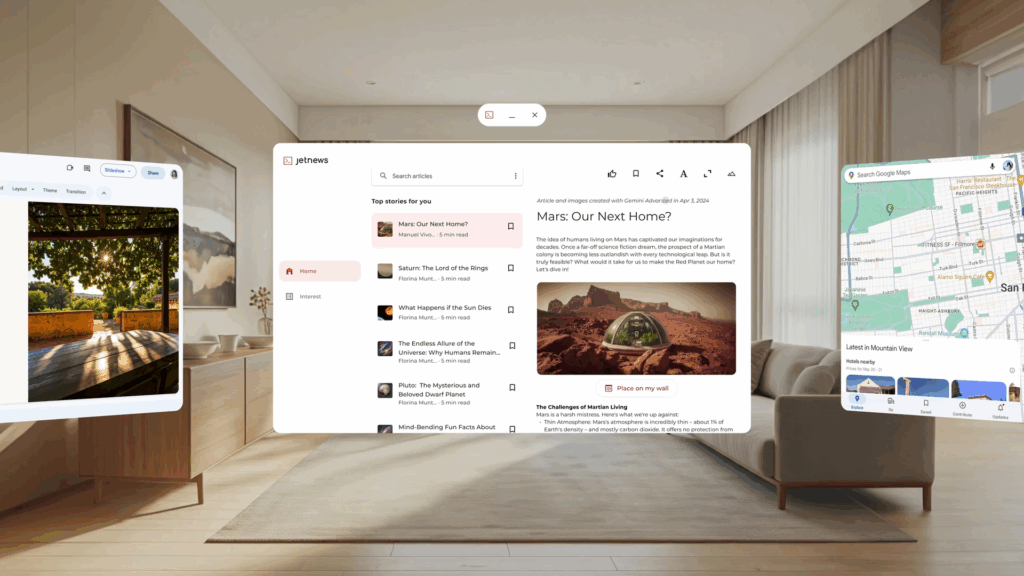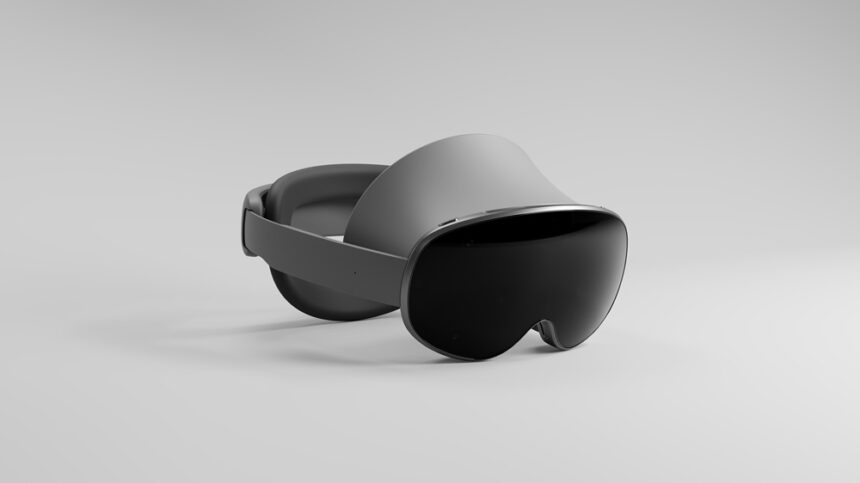A New Reality from Samsung and Google
Samsung and Google partner to introduce the Galaxy XR, the first headset built on Android XR. The result is artificial intelligence, spatial computing, and clever design in a single, immersive platform. It all feels futuristic and surprisingly, natural.
I experienced the Galaxy XR firsthand for about 15-20 minutes. From the first moments, I sensed Samsung’s ambition to challenge Apple’s Vision Pro directly. But rather than mimic Apple’s “spatial computer,” Samsung creates its own category — an AI-native device that offers digital and physical reality through voice, hand, and eye interaction.
What’s Happening & Why This Matters
Design and Fit: Light, Balanced, and Refined
The Galaxy XR surprises me with comfort. Weighing just 19.2 ounces, it feels light against the Vision Pro’s 26.4-ounce metal heft. The strap design mirrors the Meta Quest Elite strap — cushioned, adjustable, and evenly balanced. The wheel on the rear tightens or loosens easily, keeping the headset stable with no shifting or facial pressure.

Once on, I see the real world through my lower periphery while the upper field blocks light completely. The hybrid design feels deliberate — maintaining situational awareness while providing immersion. For full focus, clip-on light blockers attach under the lenses. They work well but still allow faint external light compared to Apple’s fully sealed visor.
The fit — it’s practical comfort with premium performance. It feels ready for daily use, more than short demos.
Control: The Hands, Eyes, and Voice of Android XR

The Galaxy XR recognises natural gestures. Cameras track hand movement (nearly) flawlessly, translating simple pinches, drags, and points into precise control. A finger point directs a cursor anywhere in view, while a single pinch selects. Two-handed pinches rotate or resize objects. The motion feels smooth and intuitive — though two-handed actions demand precise timing.
Eye tracking, built into the headset, enhances precision and accessibility. Combined with Gemini, Google’s AI assistant, it recognises what you look at and engages naturally in context. For example, glance at a landmark in Google Maps, ask a question, and receive information instantly — no typing, no searching.
Traditional controllers remain optional. Samsung offers twin motion wands similar to those on the Meta Quest. Each includes analogue sticks, triggers, and face buttons, giving gamers a familiar interface. Bluetooth gamepads also connect easily, showing Samsung’s commitment to open design.
Inside Android XR: The Infinite Workspace
As the first device built for Android XR, the Galaxy XR reimagines multitasking. Floating windows create a virtual workspace around you. I open YouTube, Chrome, and Google Maps simultaneously, arranging them at different distances and angles. Each window stays fixed as I move, producing an illusion of infinite space.


Switching between apps feels identical to moving between a phone and a tablet. I summon the main menu by flipping my hand palm-up and pinching my fingers. The app grid floats midair, icons glowing in crisp, vivid detail. A pinch opens, a drag moves, and the interface responds instantly.
Google Maps is a 3D world. I soar above New York, glide through streets, and even enter restaurants through 360-degree interior views. The immersion feels natural, as if stepping into a high-resolution globe. A spatial trailer for Asteroid, featuring NFL star DK Metcalf, displays cinematic depth. Dust clouds and light bursts surround me, showing Android XR’s cinematic power.
Every gesture, every app, starts a conversation between human and system — fast, intuitive, immersive.

Hardware: Vision Meets Engineering

The Galaxy XR uses dual micro-OLED displays delivering 29 million pixels total — more than the Vision Pro’s 23 million. Each eye sees a 3,552 x 3,840 resolution across a 109-degree field of view, delivering near-perfect clarity.
Eight outward-facing cameras map position, track hands, and capture the environment. Four inward cameras track eyes. Two 6.5-megapixel stereoscopic cameras stream your surroundings in real time. The Snapdragon XR2+ Gen 2 processor drives the visuals, offering 15% faster GPU and 20% faster CPU performance than the Meta Quest 3’s XR2.
A detachable battery pack powers the system for around 2.5 hours of video playback. It weighs 10.7 ounces — lighter than Apple’s external pack. It rests comfortably in a pocket, connecting to the headset via a flexible cable.
The overall performance feels effortless. No lag, no stutter — just clarity and control.
Content and Pricing: A Strong Launch Offer
Samsung positions the Galaxy XR at $1,799, half the cost of the Vision Pro. That pricing instantly shifts the mixed-reality conversation. To entice early adopters, Samsung bundles a year of Google AI Pro, YouTube Premium, and Google Play Pass — a $1,000 value.
Users also gain access to exclusive partnerships through Android XR, including immersive apps from Adobe, Calm, Fox Sports, MLB, Owlchemy Labs, and Resolution Games. The system supports OpenXR, WebXR, and Unity, ensuring developers can port and build easily.
Samsung’s marketing calls it “an infinite screen for your life.” That phrase captures its spirit. The Galaxy XR merges entertainment, productivity, and creative tools into one adaptable environment.
The Philosophy
The Galaxy XR is the start of a new Android XR-driven phase. Google’s Gemini AI integrates across the system, acting as both assistant and interpreter. It understands visuals, gestures, and speech, turning browsing into collaboration.
Users can convert Google Photos into immersive 3D memories, rewatch old moments, or explore worlds through spatial video. A simple request like, “Hey Google, organize these windows,” triggers Gemini to rearrange open apps into neat formations around your virtual workspace.
The methodology mirrors Samsung’s long-term goal: open ecosystems. While Apple restricts Vision Pro content to visionOS, Android XR invites developers from all platforms. This openness could create an entire generation of mixed-reality devices beyond Samsung’s own lineup.
TF Summary: What’s Next
The Galaxy XR transforms Android into a full spatial platform. It combines comfort, power, and openness in ways Apple refuses to match. Android XR becomes not just competition — it becomes the foundation of mixed reality’s future.
MY FORECAST: Samsung and Google now shape the immersive era together. The Galaxy XR defines what modern computing feels like when software and reality merge seamlessly. It doesn’t imitate Vision Pro — it betters it.
— Text-to-Speech (TTS) provided by gspeech
Writer: Adam for TechFyle (TF)



